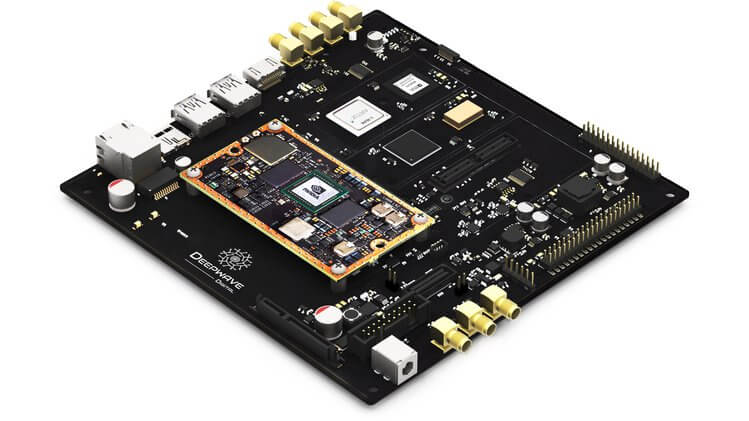The Artificial Intelligence Radio – Transceiver
Over on Crowd funding site Crowd Supply, a new SDR product is currently awaiting release of its crowd funding stage. The proposed product is called the AIR-T, which stands for Artificial Intelligence Radio - Transceiver. The basic idea behind the board is to combine a 2x2 MIMO SDR transceiver with a NVIDIA Jetson TX2 GPU that can be used to run artificial intelligence (AI) software fast.
The SDR transceiver chip used is a Analog Devices 9371. This is a high end chip that can be found on high end SDR hardware like USRPs. If you're interested we had a post about decapping the AD9361 recently, which is a similar chip. It provides 2x2 MIMO channels, with up to 100 MHz RX bandwidth and 250 MHz TX bandwidth. The NVDIA Jetson TX2 is a GPU 'supercomputer' module specifically designed for AI processing. Many AI/machine learning algorithms, such as neural networks and deep learning run significantly faster on GPU type processors when compared to more general CPU's.
These are not cheap chips with the AD9371 coming in at over US$250 each, and the Jetson TX2 coming in at US $467. Although we don't know what sort of bulk discounts the AIR-T manufactures could get. But it will be certain that the AIR-T will not be for the budget minded.
The board is still awaiting release of it's crowdfunding round, and you can sign up to be notified of when the project launches on their Crowd Supply page.
The melding of AI and the RF spectrum will be common in the future, and a development board like this is one of the first steps. Some of the interesting use cases that they present are pasted below:
Wireless
From Wi-Fi to OpenBTS, use deep learning to maximize these applications. By pairing a GPU directly with an RF front-end it eliminates the need of having to purchase an additional computer or server for processing. Just power the AIR-T on and plug in a keyboard, mouse, and monitor and get started. Use GNURadio blocks to quickly develop and deploy your current or new wireless system. For those who need more control, talk directly with the drivers using Python or C+. And for those superusers out there, the AIR-T is an open-platform, so you can program the FPGA and GPU directly.
Satellite Communications
Communicating past Pluto is hard. With the power of a single-board SDR with an embedded GPU, the AIR-T can certainly prove out concepts before you launch them into space. Reduce development time and costs by adding deep learning to your satellite communication system.
Ground Communications
There is an endless number of terrestrial communication systems with more being developed every day. As the spectral density becomes more congested, AI will be needed to maximize these resources. The AIR-T is well-positioned to easily and quickly help you prototype and deploy your wireless system.
Video/Image/Audio Recognition
The AIR-T allows you to demodulate a signal and apply deep learning to the image, video, or audio data in one integrated platform. For example, directly receiving a signal that contains audio and peforming speech recognition previously required multiple devices. The AIR-T integrates this into one easy to use package. Whatever your application is, from speech recognition to digital signal processing, the integrated NVIDIA GPU will jump start your applications.
Pattern Recognition
For many communications and radar applications once the signal is collected it must be sent to an off-board computer for additional processing and storage. This consumes valuable time. The AIR-T eliminates this. From its inception, it was designed to process signals in real-time and eliminate unnecessary latency.

This will probably be of great value.It is using some state of the art processors however it seems like its best use will be limited to certain applications
I don’t think this is very practical except in very specific applications. Expensive $, and high power consumption. I think people experimenting with “ai” and SDR will be using a full PC workstation come up with concrete algorithms, then deploying them to regular DSP hardware. Looks cool though, good luck
They need an ICO now. /s
I’m really surprised with this concept, it uses some pretty high (like waaaaaay high up in the food chain processors), even with today’s Nvidia consumer graphics cards from about the 600 series on up posses the math co-processing computing power for some pretty juicy code implementations of DSP and some pretty graphic and nifty pan-adapter data displays. Been wondering why some coding guys haven’t done it…it would pretty much rival and destroy anything the retail scammers (Icom, Yaesu,Uniden) are bringing to the table at this point…at least in the hamster world.
It’s probably going to be great but pretty expensive device
I’d love to see this work a DX pileup or CQWW contest. Sort of how chess programs can beat the world’s best players I could see where AI contesting could be used for a leg up over the competition.
This is potentially a very exciting step forward. I wonder if this tech could be applied to automatically selecting and configuring the best filtering and tuning parameters based on the state of the observable frequency spectrum. Or perhaps applying AI routines to reverse engineering a signal, automatically demodulating and decoding unknown RF transmissions. Useful for more advanced applications like passive RADAR, beam forming, etc…